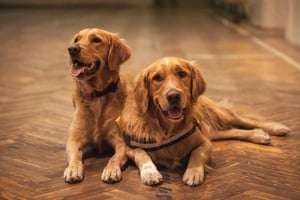Dog training is an important part of being a responsible pet owner. A dog training app can be a...
A Comprehensive Guide to German Spitz Training
Are you looking for a comprehensive guide to German Spitz training? This article will give you all the information you need to know about training a German Spitz. From basic commands to advanced tricks, we will cover it all. We will also discuss the importance of socialisation and positive reinforcement in German Spitz training. So, read on to learn more about German Spitz training.
Basic Commands
The first step in training a German Spitz is to teach them basic commands. This includes commands such as "sit", "stay", "come" and "down". It is important to start off with simple commands and gradually increase the difficulty as your German Spitz learns them. Start off with a few basic commands and repeat them often so that your German Spitz can learn them quickly. Once your German Spitz has learned these commands, they can move on to more difficult ones.
It is important to use positive reinforcement when teaching commands to a German Spitz. This means that you should reward your German Spitz with treats or praise when they complete a command correctly. This will help to reinforce the behaviour and make it easier for your German Spitz to learn. You should also be consistent with your commands and avoid using different words for the same command. This will help your German Spitz to understand what you are asking them to do.
Socialisation
Socialisation is an important part of German Spitz training. Socialisation helps to ensure that your German Spitz is comfortable in different environments and around different people. This can be done by taking your German Spitz on walks in different areas and introducing them to different people. It is important to ensure that your German Spitz is comfortable with the people and places they are introduced to. If they are not, then it is best to take a step back and give them more time to get used to them.
It is also important to ensure that your German Spitz is comfortable with other animals. This can be done by introducing them to other animals in a controlled environment. This will help to ensure that your German Spitz does not become aggressive or scared when meeting other animals. It is important to remember that socialisation takes time and patience. Do not rush it and make sure to take things slowly.
Positive Reinforcement
Positive reinforcement is an important part of German Spitz training. This means rewarding your German Spitz with treats or praise when they complete a command correctly. This will help to reinforce the behaviour and make it easier for your German Spitz to learn. You should also be consistent with your commands and avoid using different words for the same command. This will help your German Spitz to understand what you are asking them to do.
It is also important to use positive reinforcement when teaching tricks to a German Spitz. This means rewarding your German Spitz with treats or praise when they complete a trick correctly. This will help to reinforce the behaviour and make it easier for your German Spitz to learn. You should also be consistent with your commands and avoid using different words for the same trick. This will help your German Spitz to understand what you are asking them to do.
Advanced Tricks
Once your German Spitz has mastered the basic commands and is comfortable with socialisation, you can start teaching them more advanced tricks. This includes tricks such as "roll over", "speak" and "fetch". It is important to start off with simple tricks and gradually increase the difficulty as your German Spitz learns them. Start off with a few basic tricks and repeat them often so that your German Spitz can learn them quickly. Once your German Spitz has learned these tricks, they can move on to more difficult ones.
It is important to use positive reinforcement when teaching tricks to a German Spitz. This means rewarding your German Spitz with treats or praise when they complete a trick correctly. This will help to reinforce the behaviour and make it easier for your German Spitz to learn. You should also be consistent with your commands and avoid using different words for the same trick. This will help your German Spitz to understand what you are asking them to do.
Conclusion
In conclusion, German Spitz training is not difficult but requires patience and consistency. It is important to start with basic commands and gradually increase the difficulty as your German Spitz learns them. Socialisation is also an important part of German Spitz training and should be done in a controlled environment. Finally, positive reinforcement is an important part of German Spitz training and should be used to reward the desired behaviour. With these tips, you can easily train your German Spitz.



